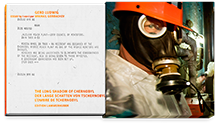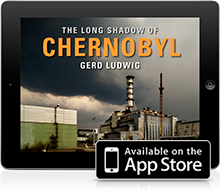About
At 1:23am on April 26th, 1986, operators in the control room of Chernobyl Nuclear Power Plant botched a routine safety test, resulting in an explosion, and a fire that burned for 10 days. The radioactive fallout spread over tens of thousands of square miles, driving more than a quarter of a million people permanently from their homes. It was the world’s worst nuclear disaster to date.
To commemorate the tragedy 25 years later, I returned to the Exclusion Zone in early 2011 to continue my coverage of the aftermath of the accident; to update it; to expand it in respect to region and content; and to take my cameras again to severely contaminated areas with the understanding that some of my explorations are not without personal risk. Like many of my colleagues, I do this on behalf of the otherwise voiceless victims who expose their own suffering solely in the hope that tragedies like Chernobyl may be prevented in the future.
As traditional news outlets struggle financially, photojournalists must now turn to alternative funding methods for long-term projects close to their heart. While many in the media have turned to celebrity reporting, photographers like myself are convinced that there is both the need and the demand for serious content. Therefore, as the 25th anniversary of the Chernobyl disaster approached, I turned to the crowd-funding website Kickstarter and pitched my idea to the public in order to help fund my long-term project. View the original Kickstarter page.
The Kickstarter campaign was a resounding success: with 435 donors, I rased $23,316 – nearly twice my initial fundraising goal. With the funds, I was able to spend 5 weeks in the region, photographing deep inside the reactor and the communities affected. See Donors and Sponsors.
The images were first exhibited in April 2011 at the EBRD headquarters in London. This special exhibit at the European Bank for Reconstruction and Development commemorated the 25th anniversary of the disaster during an international conference used to help raise the addition 1.5 billion dollars needed to build the New Safe Confinement and safely deconstruct the ailing Chernobyl shelter. The exhibit was attended by the ambassador to Ukraine and EBRD board members. See news post, Exhbition at the EBRD in London.
In May 2011, I exhibited over 50 large-format prints during the Horizonte Photo Festival in Zingst, Germany. The exhibit, held in a run-down East German navy barracks, became nearly an installation with the addition of videos, diagrams, and extended captions and summaries. See news post, Zingst Exhibition Success.
One of my goals with this project was to utilize social media and new technologies to help spread the word about the Chernobyl aftermath. In that vein, I released an App for the Apple iPad in December 2011. The App includes over 150 photos, exclusive videos, detailed essays, interactive panoramas, and resources to explore the disaster in a comprehensive manner. Learn more about The Long Shadow of Chernobyl iPad App.
Future projects include a book, currently in the works, and future exhibitions. Please check back, sign up on the Facebook page, and follow me on Twitter to keep up to date with The Long Shadow of Chernobyl project.
-Gerd Ludwig
ABOUT THE CHERNOBYL NUCLEAR DISASTER
The Chernobyl Nuclear Power Plant sits inside a fenced area known as the Exclusion Zone. Radioactive remnants of the failed reactor continue to smolder inside the so-called sarcophagus, a concrete and steel encasement hastily erected after the accident. Leaky and structurally unsound, it now threatens to collapse, shaking loose enough radiation to cause a second disaster of similar magnitude. Work has already started on a new encasement, which will slide over the existing sarcophagus to seal in the remaining nuclear fuel. In the mean time desperate efforts are underway to shore up the sarcophagus to protect it from collapsing.
In the 1970’s the town of Pripyat, only 2 miles away from the reactor, was constructed for the plant’s personnel. Its 50,000 inhabitants were evacuated 36 hours after the accident. Today a chilling ghost town, its buildings still bear witness to that hasty departure. While nature is rebounding, the town is unfit for human habitation for hundreds of years to come.
Ignoring radiation levels, hundreds of elderly people have returned to their village homes inside the Exclusion Zone, preferring to die on their own contaminated soil instead of from a broken heart in anonymous city suburbs. 70% of the fallout drifted into Belarus contaminating nearly a quarter of that country. Here mobile medical units are still reporting severe thyroid anomalies.
An earlier report by the United Nations estimated that 4,000 people will eventually succumb to cancer-related illnesses as the result of the accident. However, major environmental organizations state that more than 100,000 people have already died as a consequence of the disaster. No matter the official toll, and in light of a worldwide effort to paint nuclear energy as green energy, it is important that we remember the Chernobyl accident as a possible outcome of nuclear power.
Questions – Concerns – Need Help?
Please feel free to contact us through email anytime: [email protected]





